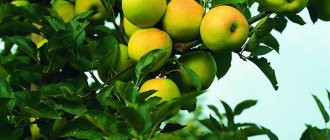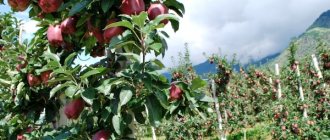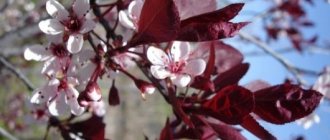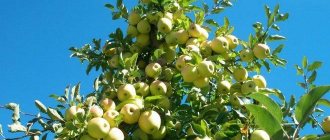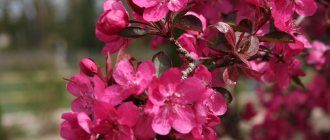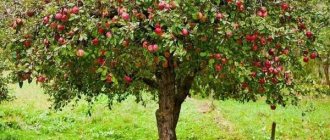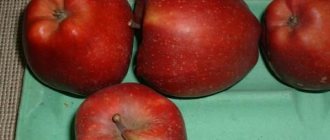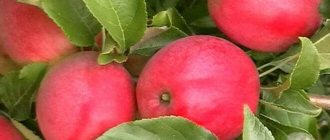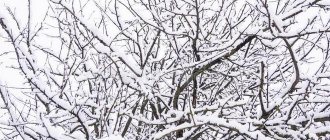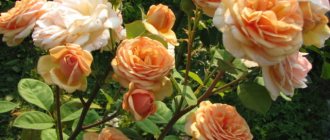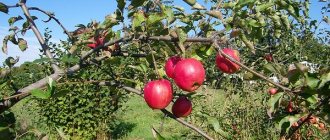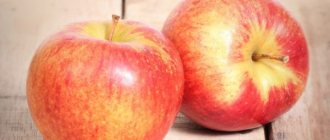History of the variety
Golden Delicious (another name for the variety is Golden Excellent) comes from America. The variety was obtained in 1890 as a result of unintentional crossing.
The tree site in Southern Virginia was purchased by interested parties to study the qualities of the new apple tree. It turned out to be interesting in terms of selection - a huge number of other varieties were bred on the basis of Golden Delicious. The fame of the caramel aroma of apples quickly spread, and soon large areas were planted with these trees to produce a tasty harvest. After many years, the variety has not lost its popularity; it is grown with pleasure in many countries, including Russia.
Reviews
Alena, Noginsk : We have been growing Golden Delicious for a long time, we are very happy. Children especially like sugar apples. We eat it calmly all winter, the harvest does not lose its taste. Sometimes only the tree freezes if the winter is too harsh.
Valery, Shatura : I tried apples of this variety from a neighbor a long time ago and immediately planted several trees at home. The fruits are simply incredible - very sweet, tasty, ideal in the form of jam. And the variety’s yield is very good; we don’t even always eat it ourselves – we share it with friends.
Description of the Golden Delicious apple tree
The apple tree is medium-sized, no more than three meters in height. A young tree has a cone-shaped crown, while an adult tree has a wide, rounded crown, prone to thickening. Due to the abundant annual harvest, the branches droop and droop. Skeletal branches extend from the trunk at an acute angle. The bark of the tree is dark gray. The shoots are medium thick, curved, light brown with a green tint, slightly pubescent, with large lentils.
The leaves are oval, wide, elongated at the ends, smooth, bright green in color. The petiole is long. Stipules are medium in size. The type of fruiting is mixed. The flowers are medium in size, saucer-shaped, white, with a slight pink tint, with a long pubescent pistil column. Stigmas are located at the level of the anthers.
A medium-sized tree with a dense and spreading crown
The fruits are medium and large in size, round-conical in shape. The skin is dense, dry, with a slight roughness. Weight depends on the region where the apple tree is cultivated. For example, in the southern regions the weight of the fruit is 140–170 g, in other areas it is slightly less.
The color of apples at the beginning of ripening is light green, then gradually acquires a golden yellow color, sometimes with a slight brown pigmentation. Often, when ripe, a pink blush appears on the sunny side. The pulp is white with a slight greenish tint, dense. When stored, it becomes creamy or light yellow, more tender and spicy. The taste is dessert, the aroma is rich.
The average weight of an apple is 150 g
Golden Delicious is a winter variety because the fruits are well preserved until April and sometimes until May. You can enjoy delicious and healthy apples all winter long.
Chemical composition of fruits - table
| Substances | Quantity |
| Solids | 14–20,5% |
| Sahara | 10–13,8% |
| Titratable acids | 0,4% |
| Ascorbic acid | 5–12.4 mg per 100 g |
| P-active substances | 100–110 mg |
| Pectins (dry weight) | 0.7 mg per 100 g |
Apple tree Golden Delicious - video
Variety varieties
Golden Delicious has varieties that have been bred in various countries through mutation. For example, Golden Delicious Rangers produce high yields of tasty apples, but require careful care, which can only be done in industrial conditions. Other clones of the variety are Starking, Royal Red Delicious.
The Jonagold variety was obtained by traditional crossing of Golden Delicious with Jonathan. Domestic varieties: Yantarnoye, Scarlet Sails, Alminskoye and others. All varieties are suitable for transportation to almost all countries.
Photo gallery: varieties of Golden Delicious
The Yantarnoye apple tree variety produces abundant yields of sweet and aromatic fruits
The Starking variety is distinguished by early fruiting and attractive fruits
Royal Red Delicious is a winter variety of American origin.
The Jonagold apple tree variety is resistant to disease, drought and frost.
The Golden Delicious Rangers variety has high yields
The Alminskoye apple tree variety is highly transportable
Scarlet Sails is a late-summer apple tree variety bred at the Crimean Horticulture Experimental Station
Advantages and disadvantages of Golden Delicious - table
| Advantages | Flaws |
|
|
Characteristic
Let's start characterizing the tree by presenting a photo and description of the variety.
The height of this tree is average . However, clones and varieties of the variety can have both low growth (dwarf forms) and above average growth (Golden Delicious).
Apple tree Golden Delicious.
Young trees have a cone- shaped crown. However, under the influence of the mass of fruits, the branches bend and after several fruitings the crown of the tree disintegrates, acquiring a spherical shape.
The color of the bark is gray, with a barely noticeable bluish tint. The bark is dense and smooth.
IMPORTANT! In order to get a harvest, it will not be enough to have only apple trees of this variety in the garden.
Pollinator varieties are needed , such as:
- Jonathan;
- Melrose.
Jonathan.
Melrose.
It is very upsetting for gardeners in central Russia that the variety does not always withstand severe frosts . Even if it is possible to preserve the tree itself, the absence of a certain number of warm days leads to the fact that the tree, even if it bears fruit, will have very small apples , and the variety will not show all its magnificent capabilities, so Golden is recommended to be planted in warm areas.
The taste of the variety is very high. Apples are never unleavened, the fruits are sweet - the sugar content reaches 20%, the aroma is pronounced, the pulp has a delicate structure and is juicy.
to bear fruit already in the 3rd year , and with conscientious care, even in the 2nd year after budding.
If seedlings are purchased already grafted, then you can expect that the tree will show its first flowers in the first year, although experienced gardeners recommend removing the flowers in order to direct all the strength of the plant to take root.
ripen within 3-4 months . This variety can bear fruit for 15-20 years, and with constant good care, even longer.
Golden, like many other varieties, cannot always resist pests and diseases.
Apple trees are especially bothered by the leaf roller (treatment with three percent nitrophen ), aphids, and mites (they need to be fought with karbofos ).
The Golden apple tree is subject to frequent attacks by aphids.
In damp weather, apple trees of this variety often develop powdery mildew and scab. To protect the tree, you should treat it with copper chloride and a solution of colloidal sulfur . It is better not to wait until the apple tree gets sick, but to use preventive treatments.
Landing Features
A healthy apple tree and a tasty harvest can be obtained by taking into account the timing of planting, the quality of the soil and the climate in the area where Golden Delicious is planned to be planted.
Selection of seedlings
It is best to purchase seedlings from specialized stores and nurseries. When buying trees in places of spontaneous sale (in markets, from private owners), there is a risk of getting a diseased seedling that was stored incorrectly. However, the nursery should also inspect the seedling before purchasing:
- roots, branches, trunk without damage or traces of disease;
- the root system is developed;
- 3–4 skeletal branches in a three-year-old seedling.
An annual apple tree does not have branches, so you will have to form the crown yourself. Before planting, I pinch off the top of the seedling and remove the buds that are directed upward (to eliminate competition with the trunk). 5–6 buds are left, directed sideways, from which skeletal branches are formed.
A three-year-old seedling should have a standard of 40–50 cm, 4–5 branches diverging at least 40 degrees from the trunk, and a conductor
Choosing a landing site
The Golden Delicious apple tree prefers open, sunny, elevated areas with deep groundwater (at least 2 m to the ground surface). Ideal illumination is achieved when planting an apple orchard in the western part of the site. Light loamy or soddy-carbonate soils are favorable for planting. Calcareous and sandy soils are absolutely not suitable.
Site preparation
Golden Delicious is a southern variety, so in warm areas it is planted mainly in the fall. In spring (mid-April) planting is carried out in regions with cold winters.
In autumn, planting activities take place in October. The hole for the seedling is prepared 3–4 weeks in advance. Dig holes 1 meter deep and wide at a distance of at least 3 m from each other. At the bottom of each of them is placed a mixture of fertilizers mixed with a fertile layer of soil. For this use:
- 1–2 buckets of humus;
- 1.6–2 kg of superphosphate;
- 120–150 g of potassium sulfate;
- 0.8–1 kg of wood ash.
Step by step process
Before planting a young tree, it is recommended to soak its roots in water for 6–12 hours. It is best to carry out the landing together.
- A wooden stake is installed in the hole, to which the seedling will be tied.
- The plant is positioned so that the root collar is at a distance of 5 cm from the ground level.
- While one person holds the seedling, the other fills the hole with soil, shaking the tree from time to time so that the soil is evenly distributed between the roots.
- Tie the seedling to a peg.
- Water the tree with 2-3 buckets of water. After planting, watering should be done every three days, using 3-4 buckets per seedling.
- Mulch the soil with humus.
It is advisable to plant apple tree seedlings in a place where fruit plants have not grown before.
Pollinators
The Golden Delicious variety is self-sterile. When planning to plant a tree on your site, you must take into account that other varieties should bloom at the same time with this apple tree. The best pollinators are species such as Wagner's prize, Delicious spur, Jonathan.
The best pollinators for the Golden Delicious apple tree variety in the photo
Jonathan is one of the most popular and widespread varieties in all areas of industrial horticulture.
The Delicious Spur variety is highly drought-resistant
Wagner prize - early winter variety of American origin
Plant care
Regular simple steps to care for the apple tree will result in gratitude for the hardworking gardener in the form of a tasty and abundant harvest.
Watering
Golden Delicious needs several waterings per season.
- The first time watering is carried out before the buds open.
- Next time - 3 weeks after flowering.
- The third watering is 3 weeks before harvest.
- The last time apple trees are irrigated is during leaf fall.
Each tree requires 4-5 buckets of water.
If the summer is dry, the amount of watering is increased. If it rains frequently, additional soil moisture is not required.
Fertilizer application
The Golden Delicious apple tree variety requires annual feeding.
Root feeding - table
| Spring | Summer | Autumn | |
| Mid April | During the process of loosening or digging, the following is added to the tree trunk circle:
| At the beginning of summer, apple trees are fed with an infusion of manure (fresh manure is poured with water and left for 2 weeks). Take 1 liter of infusion and 1 glass of ash per bucket of water. Consumption: 2–3 buckets of ready-made fertilizer per tree. | Fertilizer is applied after harvesting. For 10 liters of water:
Consumption: 10 l per 1 sq. m. |
| Flowering period | For 10 liters of water:
Consumption: 4 buckets for each tree. | ||
| After flowering | For 200 liters of water:
Consumption: 3 buckets per tree. | ||
Foliar feeding is also effective. Spraying with urea is carried out three times per season:
Kemira Lux is a complex powder-like, water-soluble fertilizer that promotes fruit formation
- before flowering;
- after flowering;
- 20 days after the second spraying.
Dilute 2 tbsp. spoons of urea in 10 liters of water. Spray the leaves, trunk and branches of the apple tree.
Effectively universal water-soluble fertilizer Kemira Lux, containing the necessary microelements. Fertilizing is carried out according to the instructions.
Trimming
It is recommended to prune trees twice a season: in early spring and autumn.
In early April, frostbitten branches are removed and a crown is formed. After leaf fall, sanitary measures are carried out to cut out broken, old, diseased, rotten branches.
Stages of autumn pruning:
- Removing large unnecessary branches.
- Thinning branches that are close to each other.
- Pruning branches growing at an acute angle.
Anti-aging pruning of the apple tree crown allows you to extend the fruiting period
All cut areas must be covered with garden varnish. The cut branches are taken outside the site and burned.
- At the age of two or three years, one-year-old apple tree branches are shortened by a quarter.
- In five-year-old trees, mature branches are cut to a third of their length so that the sun illuminates the fruit better.
In summer, pruning is not done due to intense sap flow.
Preparing for winter
In addition to digging up the soil, watering and fertilizing before winter, the apple tree must be protected from rodents. This event is carried out in late autumn (with the first frosts).
The tree trunk is whitened, then covered with any available material: newspapers, old rags, burlap, roofing felt, sunflower stems, spruce wood.
Experienced gardeners recommend using foamed polyethylene for this purpose, which is used for thermal insulation of pipes. It is cut along the weld seam and wrapped around the trunks of the apple tree. Foamed polyethylene of any diameter can be found at a hardware store.
By wrapping the trunk of a young apple tree in the fall, you don’t have to worry about rodents damaging it
Features of growing in the Moscow region
For cultivation in the Moscow region, it is recommended to choose clones with increased frost resistance. Even this does not guarantee that the trees will survive the cold winter, so coverings cannot be avoided. Another requirement is to pay attention to watering. In hot summers, add at least a bucket to each adult plant. It is necessary to carry out loosening, allowing moisture to penetrate deep into the soil.
Golden is a variety that has long been loved by gardeners. A distinctive feature of the culture is its high taste and shelf life. If you immediately send the fruits to a cool room after harvesting, you will be able to enjoy healthy apples full of vitamins until spring.
Apple tree diseases and pests
The Golden Delicious apple tree variety is susceptible to diseases such as powdery mildew and brown spot.
Timely detection of signs of disease or pests, as well as quickly taken measures, will help preserve the harvest.
Fighting apple tree diseases - table
| Disease | Nature of the lesion | Processing period | Control measures | Prevention |
| Powdery mildew | Dense white coating on inflorescences, leaves and shoots. |
|
| Balanced feeding with potassium and phosphorus fertilizers. |
| Brown spot | Light spots with a brown rim on the leaves. |
|
|
|
| Scab | Brown coating on the leaves, turning into black spots and cracks. |
|
|
|
| Before the buds open. | Infusion of horsetail: 1/3 of a bucket of the green part of the plant, pour 10 liters of water, leave for 3 days. | |||
| Premature abscission leaves | Dropping leaves after a dry period. | 10 days after flowering. | 0.2% magnesium sulfate. Spraying is carried out 2-3 times with an interval of 10-14 days. | Compliance with agricultural technology. |
Apple tree diseases in the photo
Premature leaf fall is a sign of unfavorable living conditions for the plant, which can lead to its death.
Scab is one of the most common diseases of apple trees.
Powdery mildew affects both mature and young trees
In years with wet summers, brown spot can develop very severely, leading to significant weakening of leaves or premature defoliation
Pest control - table
| Pest | Nature of the lesion | Processing period | Control measures | Prevention |
| leaf roller | Damages leaves, inflorescences, fruits, buds. | Early spring (before flowering). |
| Before buds open, 0.5 liters of Profilaktin per 10 liters of water. Consumption: 2–5 liters per tree. |
| Green aphid | Leaves and shoot tips curl and dry out. | Before the buds open. |
| Burning leaves. |
| During bud break (fight against larvae). |
| |||
| Apple mite | Entangles leaves with cobwebs. |
|
|
|
| Apple flower beetle | It feeds on buds, stamens and pistils. | Before flowering. |
Consumption: young tree - 2 l, fruiting tree - 5 l. |
|
Apple tree pests in the photo
The apple blossom beetle causes great damage, damaging more than 50% of the buds
Apple mite damages tree leaves
Leafworm caterpillars feed on leaves, folding them in various ways
Green aphids damage young trees and seedlings by sucking juices from leaves and shoots
Using catcher belts to protect apple trees from pests - video
Pros and cons of the variety
It is quite difficult to list the advantages of apples; there are not so few advantages over other varieties. Among them:
- high yield (more than 100 kg per mature tree);
- undemanding;
- endurance;
- resistance to adverse climatic conditions;
- taste qualities.
There are also disadvantages - Golden is susceptible to diseases. You will have to carry out regular treatments against scab, rot, and powdery mildew. Another disadvantage of this variety is that it does not tolerate frost well, so it will need a cover.
See also
Description and characteristics of the Melba apple tree, tree height and ripening time, careRead
Harvest and storage
The Golden Delicious variety is fast-growing, the first apples appear 2-3 years after planting. The time to harvest ripe fruits comes at the end of September. A young tree bears fruit regularly, then the yield depends on compliance with gardening technology. In addition, there is a great dependence of the variety on weather conditions. Often, to preserve its strength, an apple tree chooses periodic fruiting.
With good growing conditions and proper care, you can harvest 80–120 kg of fruit from one tree.
High yield is one of the advantages of the Golden Delicious variety
Before storing apples, they should be carefully inspected. Fruits collected with the stalk that do not have wounds, dents or other defects are subject to storage.
It is worth selecting a separate room (in the cellar, basement, pantry) with a constant temperature from 0 to +4 °C and a humidity of 85–90%. If there is insufficient moisture, the fruits will begin to wilt.
If you plan to store several varieties, then each of them will need a separate box.
When storing apples, they can be placed on shelves in drawers. The fruits are placed in one layer. Apples will last longer if they are not in contact with each other.
In wooden boxes, storage is possible in several layers. In this case, each fruit must be wrapped in paper. Rows of apples are also separated with paper.
Golden Delicious apples are extremely tasty fresh. They are also used to make compotes, jams, jams and other winter preparations. The fruits are also excellent for drying.
Golden Delicious apples can be used to prepare any winter preparations.
Advantages and disadvantages
Let's look at the strengths of this variety:
- good yield;
- fruiting occurs early;
- ripe fruits do not fall off;
- the apple tree tolerates winter in regions with warm or temperate climates;
- the presentation is preserved for a very long time, the shelf life is long;
- the harvest is not afraid of transportation;
- apples are suitable for consumption in various forms.
And now a little about the weaknesses:
- without pruning, the fruits become smaller;
- the variety is afraid of drought;
- the harvest may be periodic;
- the plant is not immune to brown spot and powdery mildew;
- fruits wilt if there is insufficient humidity in the storage room.
